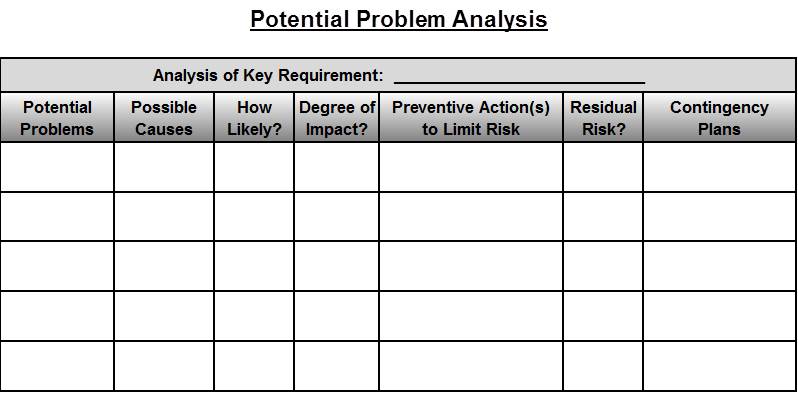
Potential Problem Analysis
Analyze your solutions for potential problems.

The Potential Problem Analysis tool is designed to provide a proactive analysis of a solution in order to determine the ways it could possibly go wrong.
It provides a rational and systematic approach for anticipating the causes of high risk problems that can hinder the success of your solution. It can also help you develop preventative actions and contingency plans to mitigate those risks.
Analyze Potential Problems in Your Solution
Step 1: Define your key requirements. These are the actions or events that must take place if your solution is to be successful. Failure of any one of these key requirements is likely to cause major problems. For help identifying your key requirements, see our Chronology tool.
Step 2: Create a table to display the analysis of each key requirement (see the Form below).
Step 3: Write one of your key requirements into the blank at the top of the form.
Step 4: For each one of your key requirements, make a list of all of the potential problems. You may use our Negative Brainstorming tool to find ways that a key requirement may go wrong.
Step 5: List your Potential Problems down the left-hand column.
Step 6: List possible causes for each potential problem. Investigate the causes of potential problems using probing techniques, such as: Who, What, When, Where, Why, How, From Where, & To Where. You can also use one of our root cause analysis tools, such as, a Cause and Effect Fishbone Diagram.
Step 7: Determine the risk associated with each cause. Risk assessment reflects both the likelihood of an event and the severity of the impact, if it did happen. Potential problems with causes that have both ‘high likelihood’ and ‘high impact’ present the highest degree of risk. The table can contain a variety of risk descriptions from crude (ex. high, medium, and low) to highly sophisticated calculations.
Step 8: Develop preventive action plans and determine residual risk. Where possible try to develop ways of preventing potential problem causes or minimizing their effects. Now estimate the residual risk that might still remain (even if preventative actions were taken).
Step 9: Develop contingency plans. These are necessary when problems have serious side-effects that you can’t prevent.
Potential Problem Analysis Form: Use this form to analyze your solutions for potential problems.

PRINTABLE: Excel version of Potential Problem Analysis.xlsx (Click link to download Excel version).
PRINTABLE: Word version of Potential Problem Analysis.docx (Click link to download Word version).
PRINTABLE: PDF version of Potential Problem Analysis.pdf (Click link to download PDF version).
Sources:
 |
The Rational Manager: A Systematic Approach to Problem Solving and Decision-Making by Charles H. Kepner and Benjamin B. Tregoe, New York: McGraw-Hill, 1965. |
MyCoTed.com website.

